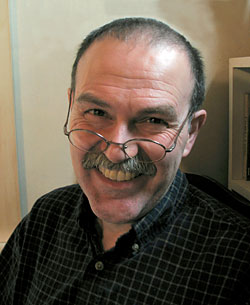Crowd Control
By Dave King | June 16, 2020 |
 If you read writing books, you know that your characters should say whatever they say, with no help from you. “John said” or “Mary said.” Neither spluttered, murmured, extemporized, or expostulated. And no one ever said anything with an adverb attached – apologetically, artfully, dolefully, anything. In early to mid-20th century books, even successful authors just added “-ly” to any adjective, however unlikely — I’ve seen “boringly” and “heart-warmingly.” I think that habit is what killed the questionable art of adverbial speaker attribution.
If you read writing books, you know that your characters should say whatever they say, with no help from you. “John said” or “Mary said.” Neither spluttered, murmured, extemporized, or expostulated. And no one ever said anything with an adverb attached – apologetically, artfully, dolefully, anything. In early to mid-20th century books, even successful authors just added “-ly” to any adjective, however unlikely — I’ve seen “boringly” and “heart-warmingly.” I think that habit is what killed the questionable art of adverbial speaker attribution.
It’s easy enough to know who is speaking when you only have two or three characters in a conversation. In fact, with two, you don’t have to do anything except let them talk – your readers can just follow the back and forth. But what do you do if you have a crowd to manage – a dinner party or the denouement of a complicated mystery?
The first step in keeping a chatty crowd under control is to know all the different ways you can flag the speaker of a line of dialogue. Speaker attributions, of course. “’We’ve got some old friends coming over tonight,’ Mary said.” But if you start ending every paragraph with a “said,” your readers are going to start tripping over them.
Injecting a little bit of action before a line of dialogue can flag a speaker. “Sky held out a hand with dirty fingernails. ‘Hey, dude, it’s been, like forever.’” You can also use a little interior monologue from your viewpoint character. “John could not for the life of him understand why Mary had invited Sky and Lotus Petal. They hadn’t seen them in years. But he may as well make the most of it. ‘It has. Good to see you again.’”
In fact, it’s a good idea to let readers know how your viewpoint character is reacting to the dialogue happening around him or her. If your characters are real people to you, it’s not hard to get caught up in the conversation and forget your viewpoint character is there. That’s how conversations break down to a series of talking heads.
Speaking of your viewpoint character, you can often draw your readers’ attention from one speaker to another by focusing on what drew your viewpoint character’s attention from one speaker to another. And if your viewpoint character has a strong opinion of what’s happening, that can anchor the dialogue even more. “As Lotus Petal spoke, John heard a familiar scratching sound to his right. He turned.
“Sky was lighting a joint in their living room.
“‘Please don’t. We don’t even have ashtrays any more.’”
If a character has a distinctive voice, that’s often enough to identify them without any additional help on your part. “Chill, Dude. You’re harshing my mellow.”
Direct address can show who a character is talking to. “Look, Sky, I’m sorry, but we’re really not comfortable with smoking – anything – in the house.”
If, in the middle of a broader discussion, two characters get into a rapid-fire exchange, you can drop any other forms of identification.
“’Wow,’ Lotus Petal said, ‘you really have sold out, haven’t you?’”
“’Don’t start,’ Mary said. “’We’ve invited you into our home.’”
“You weren’t so uptight back in college.”
“You knew how to behave like a guest back then.”
“And you knew how to make a guest feel welcome—”
“’Ladies, ladies . . . ‘ Sky snuffed the joint out with two fingers and put it in his pocket. ‘We’re all good, right?’”
Once you’re aware of these different approaches to tagging a line of dialogue, all you have to do is mix them up randomly. Be careful not to fall into a pattern. It’s easy to do out of sheer force of habit, but readers will start to notice if your dialogue mechanics develop a rhythm.
And above all, keep the conversation dynamic, with more going on than just the words. Use all these techniques — the beats and interior monologue, the rhythm of the dialogue – not just to show who is saying what but to show how characters react to one another and play off of one another. That’s how you make even a complex conversation a living, organic thing.
[coffee]










A solid list of tips.
I don’t agree that we should *never* use tags like “murmured” (though “extemporized” is right out) or “said loudly.” But, they’d only be right if the moment calls for just a sliver of detail and no more attention than that. They’re riskier than the other methods, and it’s better to either trim the tag down to Said (or no tag at all) or expand it to a gesture or reaction (Show Don’t Tell).
Your last point nails the real need. I think the real reason writers fall back on those weak fence-straddling tags (or refuse them but overuse “said”) is they lose track of how many options they have, and stop trying to keep it organic. Traffic control is an opportunity to make everything stronger (or get out of the way, at the right times), not just an obligation.
You’re absolutely right on both counts. In fact, much of what I do as an editor is open clients’ eyes to possibilities they may not have seen.
And note that both of your examples describe the physical act of speaking rather than the emotion behind the dialogue. Other possible — occasional — exceptions are verbs like “whispered” or “shouted.”
Loved it.
Playboy used to do a feature called “Tom Swifties,” which delivered funny examples of what you refer to in your piece.
The only one I remember was:
“How about a roll in the hay,” said Tom, loftily.”
We included a few Tom Swifties in Self-Editing, as well. My favorite was, “‘Don’t worry, the radiation level isn’t very high,’ Tom said, glowingly.”
That was such a great ‘showing’ of how to do this! Thank you
Credit there goes to my editor, business partner, and wife, Ruth. The first draft had a long and ponderous example from Rex Stout. She suggested using a growing scene to illustrate the points.
I guessed that you wrote this post before I even read your name. That’s because you’re the one who taught me the importance of crowd control a few years ago and it’s stayed with me. Great advice. Thank you.
I remember working with you very well — that was an astonishing and wonderful book. Please, send me an email and let me know how it’s going.
As long as we’re on the subject, I would like to beg your indulgence for a related question. In emulation of two of my heroes, Robert B. Parker and Lawrence Block, I have gradually stripped the verbs down to “said” or nothing. Even when a character asks a question, I usually use “said,” as in,
“Are you going to pick that up?” I said.
I feel that using “said” in that case actually adds a little something to the character of the speaker. “I asked” seems softer—and unnecessary, because the question mark is right there. Unfortunately I have never had a first reader who didn’t lobby for “asked,” saying that framing the sentence as I did above drives them crazy.
Any thoughts?
I’m with you and Robert B. Parker.
“Said should rule,” I said.
I don’t make a law of sticking solely to a bald ‘said’, but I have read – ok, read part of – a novel which eschewed the word entirely.
So you’d have ‘”Welcome back,” he greeted.’ Like ‘greeted’ is an intransitive verb now.
As the saying goes, if you can’t be a good example, you’ll just have to be a horrible warning.
A lot of what I talk about in the article is how to get rid of even the “saids.” I agree that “said” is the word you want. It’s not really read, kind of the way the word “that” isn’t really read. But if you pile too many of them together, they start to get noticed.
Which, of course, is a good excuse to quote my favorite passage from The Spectator, a daily broadsheet published in 1711 and 1712 — think of it as the Queen Anne equivalent of a blog. On Wednesday, May 30, 1711, the Spectator published a letter from the words WHO and WHICH, complaining that they were being constantly replaced by the upstart THAT. On Friday, June 1, THAT sent a reply, saying in part:
They [WHO and WHICH] may find fault, and correct Speeches in the Senate and at the Bar: But let them try to get themselves so often and with so much Eloquence repeated in a Sentence, as a great Orator doth frequently introduce me.
“My Lords! (says he) with humble Submission, That that I say is this; that, that that that Gentleman has advanced, is not That, that he should have proved to your Lordships.”
Let those two questionary Petitioners try to do thus with their WHO’s and their WHICH’s.